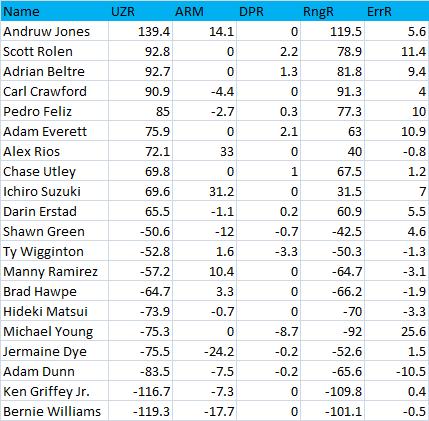My drafting strategy for pitching was about value retention. Whenever you draft high value pitchers, you are taking on a bunch of risk by forgoing valuable multi-category hitters to take someone from a deep position that features much volatility.
Undrafted guys like Cliff Lee and Ryan
Dempster often outperform big name guys like Carlos
Zambrano each season, but they usually don't repeat -- at least not at the same level. Guys like
Lincecum have great seasons, but then become overrated, overvalued and often placed in questionable positions of health (consult PAP!).
So my strategy for drafting starting pitchers was firmly placed on the following dynamics:
1)
FIP and
xFIP2) D/E and Aggregate Fielding Runs
3) LOB%
4) K/9
5) PAP and the
Verducci Effect
I focused on
FIP for obvious reasons. I wanted to know whose success was "for real" (
ie, Dan
Haren) and whose success was the byproduct of luck (
ie, Gavin Floyd). As I often advocate everyone do, I checked ERA/
FIP splits and tried to avoid guys whose
ERAs didn't quite match up with their
FIPs. I strongly believe that guys who outperform their
FIPs - like Johan Santana - even if they are great, will be incredibly overvalued. Furthermore, I checked
FIP to find guys who UNDERPERFORMED their abilities last year. I hunted down guys like Jonathan Sanchez and Javier Vazquez, who posted quality
FIPS below 4, but
ERAs upwards of 4.5. Guys like Vazquez, who get an "
unclutch" label, are perfectly undervalued targets.
Following
FIP, I looked at the Defensive Efficiency (a metric that analyzes how efficient teams are at converting balls put into play into outs) and a team's cumulative fielding runs above/below average (broken down by infield, outfield and whole team). The goal here was to find out which teams are very good, average and below average at fielding. By determining this, I could figure out which pitchers could reasonably outperform/
underperform their
FIPs for 2009. I can confidently state that a guy like James Shields -- a
groundball pitcher backed by the game's best defensive infields -- is going to continue to outperform his already quality
FIP going forward. At the same time, I question whether or not the Rockie's defense (amongst other factors) provides enough coverage to match
Ubaldo Jimenez's quality peripherals to his ERA.
I then looked at player's Left On Base Percentages (LOB%) to see whether or not which pitcher's
ERAs were strongly biased due to positive/negative luck. Since non-HR hits are incredibly situational, you have to expect a lot of regression towards the mean in a player's LOB% from year to year. Guys with large
FIP/ERA splits like Jonathan Sanchez -- who is on a defensively challenged team, but also posted an unlucky 67.5 LOB% (league average is 72.5%) -- scream value to me. At the same time, Johan Santana's declining peripherals and league leading 82.6 LOB% tells me that not only would I be overpaying for Santana, but that his "return to form" year may have not actually been a return to form.
After
FIP, Fielding Runs and LOB%, I looked at guys based on K/9 rates. I figure that if I am going to excel in any category, I want it to be the one pitchers have the most control over. Teams can unexpectedly suck (low Wins total), while Save
Opps, WHIP (which is comprised of HITS) and ERA are all situational. Pitchers have absolute control over only exactly three things: strikeouts, walks and home runs. Thus, choosing high K guys is the most logical thing to do. Plus, guys with higher K rates tend to perform closer to their
FIPs due to their "ability to get out of jams" without relying on the defense behind them. In terms of pitching K/9 is pretty consistent, which is important to a drafting strategy of value retention (minimizing risk).
Finally, I checked out how abused pitchers were last year to decide whether or not I wanted to take on the risk of injury by drafting them. Young pitchers (under 26) who had huge inning leaps (Cole
Hamels increased his workload by 44 innings last year) or heavy workloads (Tim
Lincecum lead the league in PAP points) scare me -- especially if they go in the top 6 rounds. As I pointed out in
my analysis of John Danks,
Baseball Prospectus has shown, pitchers are most brittle before the age of 24 and after the age of 35. Tom Verducci observed that pitchers under the age of 25 who increase their seasonal workload by more than 25-30 innings in a single season are the most susceptible to injury the following year.
I adhere strongly to that data.
As should be evident by my picks of Dan
Haren (Dr. Consistent), Javier Vazquez, Josh Beckett,
Yovani Gallardo, Erik
Bedard, Jonathan Sanchez, Manny
Parra and Brandon Morrow should indicate, I stuck pretty closely to my value retention strategy. The only high risk, late round guy I pulled was Morrow -- largely because he's got so much upside and will either be a quality starter or the team's closers.
As you should also already know by now,
I hate closers, so it shouldn't
surprise you that I picked up Jason
Motte, Leo Nunez and Chad
Qualls to supplement Jose
Valverde -- who is one of the best
RPs in baseball and one of the very few closers (the others being Joe Nathan, Kerry Wood, Jonathan
Broxton and maybe Heath Bell) I would ever consider drafting "early."
Go know and use my knowledge, dear child.






